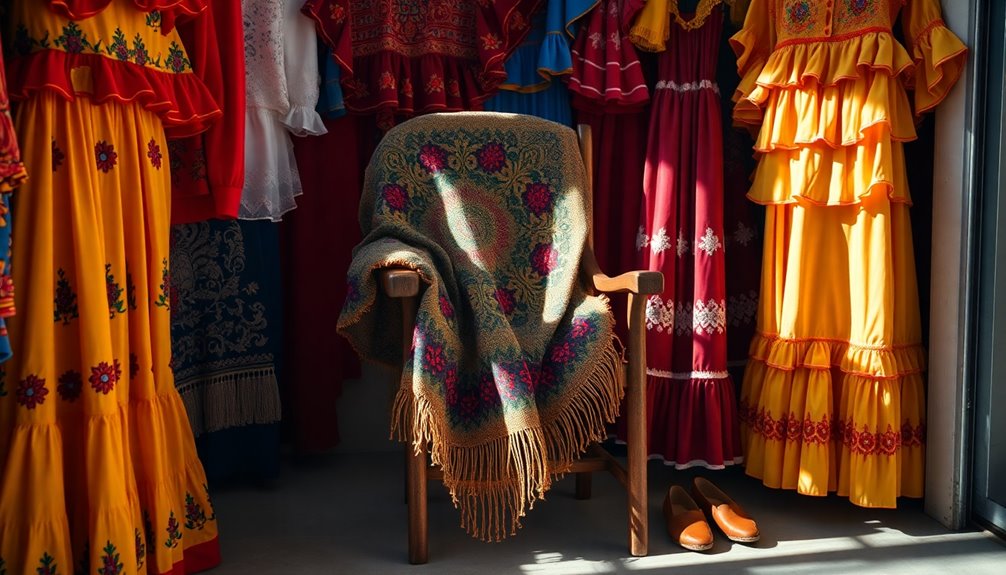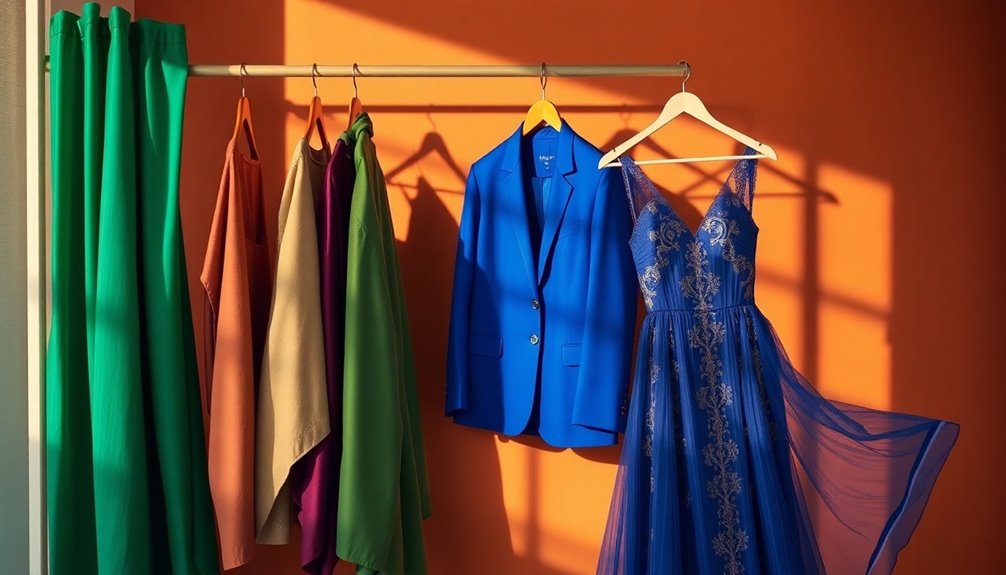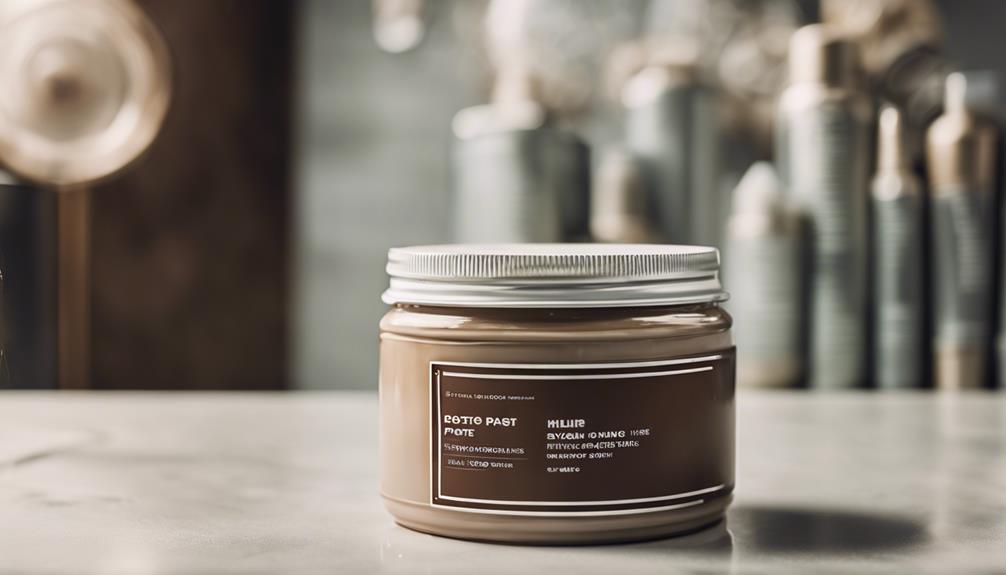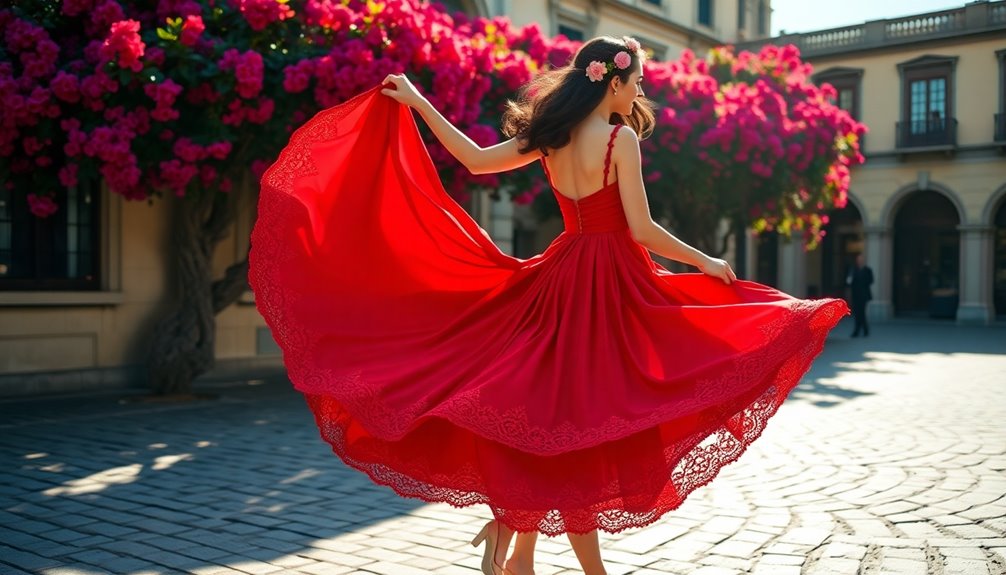Building a wardrobe steeped in Spanish tradition means embracing vibrant colors, luxurious fabrics, and intricate designs. Start with iconic pieces like the flamenco dress, known for its ruffles and bold patterns. Incorporate accessories such as mantillas and espadrilles to amplify your look. Choose textiles like silk and cotton, which embody comfort and elegance, while showcasing regional motifs. Modern interpretations blend these traditional designs with sustainable practices, adding a contemporary edge to your outfits. By mixing textures and patterns, you'll create eye-catching ensembles. Curious about more styling tips and cultural insights? There's plenty more to explore!
Key Takeaways
- Incorporate traditional garments like flamenco dresses and traje fallera to celebrate Spanish cultural heritage and add vibrant flair to your wardrobe.
- Opt for fabrics like silk and cotton, showcasing the luxurious feel and breathability essential for both special occasions and everyday wear.
- Accessorize with mantilla and peineta, which enhance traditional outfits and add elegance to your overall look.
- Experiment with bold colors and floral patterns, reflecting the lively spirit of Spanish fashion in your outfit combinations.
- Support sustainable fashion by choosing brands that blend traditional techniques with modern designs, honoring both heritage and the environment.
Origin and historical background of the fashion trend/style
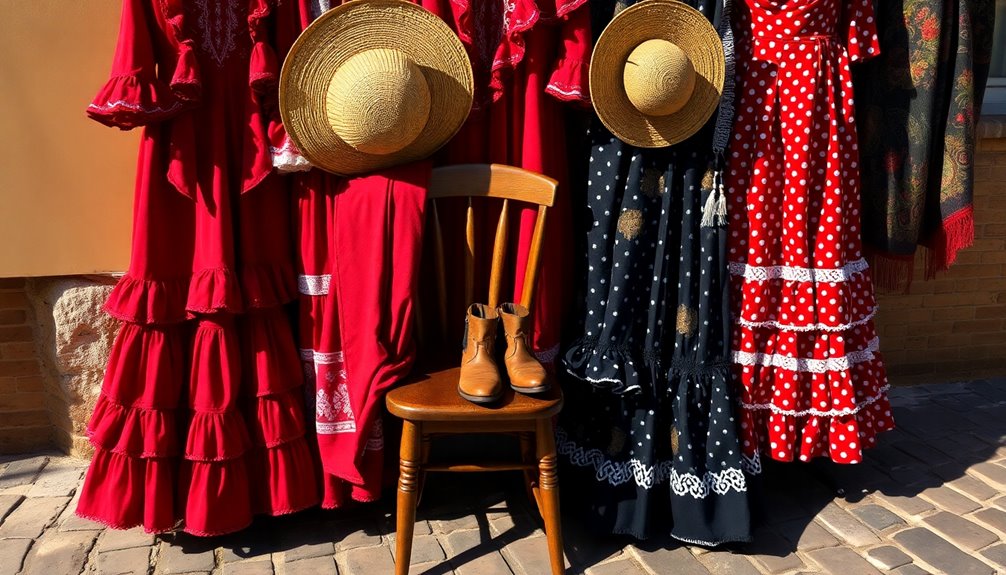
Spanish fashion's journey is a fascinating blend of historical influences, especially from the Moors, who introduced intricate designs and luxurious fabrics.
As you explore traditional garments, you'll notice how these cultural exchanges shaped what you see today.
Understanding this evolution helps you appreciate the rich heritage woven into each piece of clothing.
Historical Development of Fashion
Fashion in Spain showcases a rich tapestry woven from centuries of cultural influences and historical events.
You'll find that Spanish fashion traces its roots back to the Visigoth period (5th-8th centuries), where German-inspired clothing styles began to emerge. The 8th century brought the Moorish conquest, which transformed Spanish attire with the introduction of luxurious fabrics and intricate embroidery, reflecting Islamic aesthetics.
As you delve into the Renaissance, Spain became a fashion leader in Europe, thanks in part to the Habsburg monarchy, which popularized garments like capes and farthingales. These styles not only defined Spanish culture but also influenced global fashion trends.
However, the 17th century marked a shift as French innovations took center stage, prompting a decline in Spain's fashion dominance.
Despite this, traditional clothing remains vital to Spanish culture. Garments like the flamenco dress and traje fallera are celebrated during regional festivals, preserving Spain's clothing customs and historical essence.
Today, you can appreciate how these influences meld together, allowing you to build a wardrobe steeped in the rich tradition of Spanish fashion.
Cultural Exchanges With Moors
During the 8th century, the Moorish conquest of the Iberian Peninsula ushered in a transformative era for clothing styles in the region. You'll notice that traditional Spanish clothing began to reflect the rich influences of Moorish fashion. Intricate embroidery, luxurious fabrics, and innovative design elements created a striking contrast to the more rigid styles of the time.
Moorish clothing emphasized modesty and elegance, with flowing garments for both men and women. This shift not only enhanced comfort but also introduced vibrant colors and elaborate patterns to Spanish attire. The artistic techniques and textile craftsmanship from the Moors played a vital role in shaping your clothing culture.
Key garments like the gilet and mantilla showcase the blending of Islamic and Spanish influences, highlighting the enduring impact of Moorish fashion.
Additionally, the architectural and decorative styles of Moorish culture inspired Spanish fashion, leading to the incorporation of geometric designs and floral motifs into traditional clothing. This fusion of styles creates a unique wardrobe that honors a rich historical narrative, allowing you to celebrate the cultural exchanges that have shaped Spanish fashion for centuries.
Key Characteristics
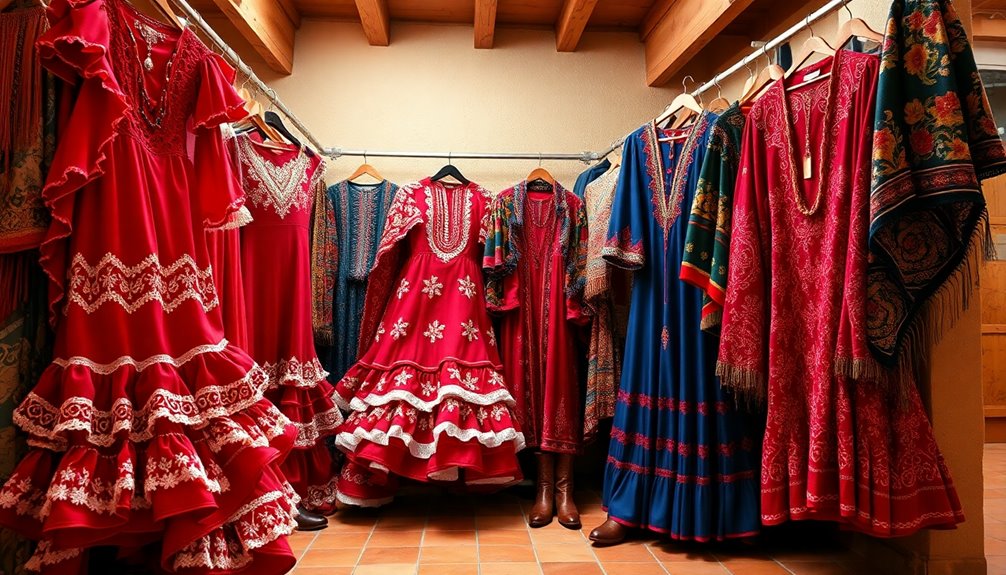
When you explore Spanish style clothing, you'll notice the vibrant embroidery and unique patterns that bring each piece to life.
The use of rich silk and cotton fabrics adds to the luxurious feel, making garments like the flamenco dress truly stand out.
These key characteristics not only reflect Spain's cultural diversity but also celebrate its artistic heritage.
Vibrant Embroidery and Patterns
Spanish traditional clothing is known for its vibrant embroidery and patterns that showcase the country's rich cultural heritage. Each region has its own unique motifs and floral designs, reflecting local traditions and artistic influences.
For instance, flamenco dresses often feature lively polka dots and ruffles, symbolizing the passion and spirited nature of Andalusian culture.
Garments like the traje de fallera from Valencia stand out with their bold, contrasting colors, enhancing their visual appeal during festive occasions. The intricate embroidery techniques, including the use of silk threads and gold embellishments, reveal a historical connection to Moorish influences, highlighting the fusion of cultures in Spanish fashion.
You'll notice that traditional dress varies across Spain, with each area boasting distinct patterns and textures that illustrate the country's diverse cultural tapestry.
This attention to detail and craftsmanship in vibrant embroidery not only enhances the beauty of the attire but also serves as a testament to Spain's rich history and artistry. Embracing these elements in your wardrobe allows you to celebrate and connect with Spain's vibrant cultural heritage.
Vibrant Silk and Cotton
The vibrant silk and cotton fabrics used in traditional Spanish clothing play a significant role in defining the unique character of each garment. You'll find that vibrant silk often adorns luxurious pieces like the mantilla and traje de fallera, giving them an elegant sheen that captures attention. This luxurious texture elevates your traditional costumes, making them perfect for festive gatherings or cultural events.
On the other hand, cotton fabrics are staples in everyday wear, such as the chulapo and chulapa costumes. They provide breathability and comfort, making them ideal for warm climates and lively celebrations.
The combination of vibrant silk and cotton reflects the rich cultural heritage of Spain, showcasing the craftsmanship and artistic expression inherent in these materials.
Moreover, the floral embroidery and intricate designs woven into both silk and cotton fabrics highlight the diversity across regions. Each area adapts its materials and styles to reflect local customs, giving you a wardrobe that's not only stylish but also steeped in tradition.
Embrace these vibrant silk and cotton fabrics to truly capture the essence of Spanish fashion.
Flamenco Dress Silhouette
Embodying elegance and flair, the flamenco dress, or traje de flamenca, captivates with its fitted bodice and ruffled, flared skirts that gracefully reach the ankles. This traditional clothing highlights your figure while allowing for movement, which is essential for the expressive dance style it represents.
Typically crafted from vibrant cotton and silk, flamenco dresses are adorned with bold polka dots, floral patterns, or striking solid colors that reflect the passion of flamenco culture. While long sleeves are common, sleeveless options are also available, especially for performances or festive gatherings.
The silhouette of the traje de flamenca is further enhanced by accessories like the mantón de Manila, a beautifully decorated shawl, and flowers pinned in your hair, adding a touch of elegance and femininity.
Over the years, the flamenco dress has evolved, absorbing modern influences while retaining its traditional roots, which allows you to embrace both heritage and contemporary style.
Wearing a traje de flamenca not only connects you to Spanish culture but also empowers you to express yourself through its dramatic and enchanting silhouette.
Modern Interpretation
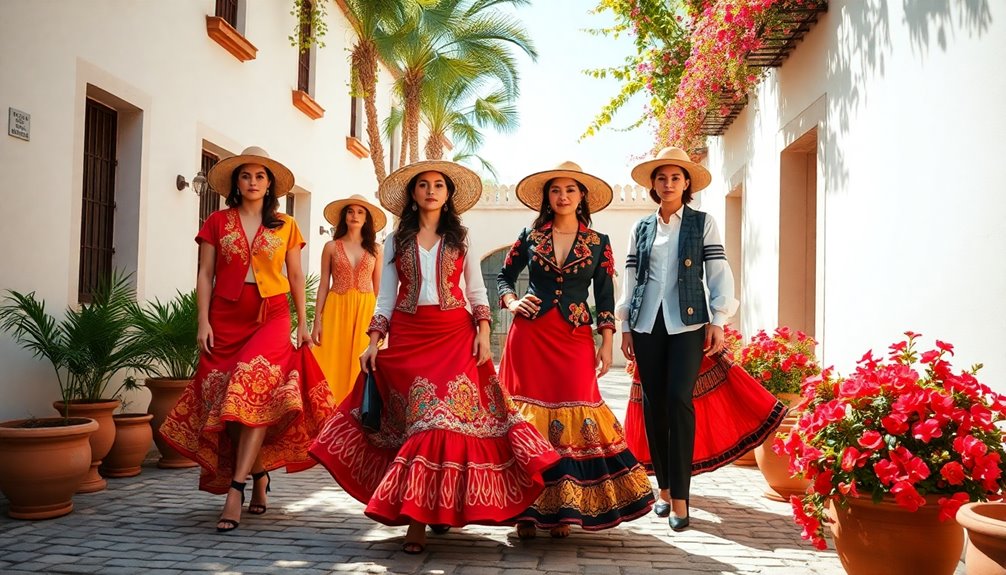
When you explore modern interpretations of Spanish style, you'll notice a strong emphasis on sustainable fashion initiatives and renowned fashion houses.
Designers are blending traditional craftsmanship with contemporary trends, making cultural heritage both stylish and eco-friendly.
Plus, fashion icons in Spain are showcasing these fresh looks, proving that classic elements can thrive in today's fashion landscape.
Sustainable Fashion Initiatives
Sustainable fashion initiatives in Spain are breathing new life into traditional craftsmanship, making it more relevant in today's eco-conscious world. By reviving the skills involved in traditional garment making, these initiatives encourage ethical production methods that honor both the environment and cultural heritage.
Workshops organized by various organizations allow you to engage directly with these age-old techniques, ensuring that they're passed down to future generations.
Contemporary Spanish designers like Adolfo Dominguez are leading the charge by integrating traditional textiles and techniques into their collections. This not only emphasizes sustainable fashion but also celebrates Spain's rich cultural heritage.
Brands such as Ecoalf further showcase commitment to sustainability by utilizing recycled materials and championing the circular economy.
Cultural festivals across Spain often highlight sustainable fashion through showcases featuring traditional attire made from organic and locally sourced materials. These events raise awareness of the environmental impact of clothing choices.
Additionally, museums curate exhibits on traditional clothing while addressing sustainable practices, educating the public about the importance of preserving both cultural heritage and the environment.
Renowned Spanish Fashion Houses
Spanish fashion houses have long been at the forefront of blending traditional craftsmanship with contemporary design. Take Balenciaga, for instance. Founded by Cristóbal Balenciaga in 1919, it's renowned for innovative designs that seamlessly integrate traditional Spanish elements with modern aesthetics, setting trends worldwide.
Similarly, Paco Rabanne has redefined Spanish fashion since the 1960s, using unconventional materials and drawing inspiration from Spain's rich cultural heritage.
Adolfo Dominguez stands out with his focus on natural fabrics and sustainable fashion, skillfully incorporating traditional Spanish silhouettes into contemporary clothing. His work emphasizes the importance of craftsmanship and cultural identity.
Designers like Antonio Marras and Manolo Blahnik also make their mark by integrating Spanish motifs and artisanal techniques, showcasing the significance of traditional craftsmanship in today's fashion landscape.
Even fast fashion brands like Zara and Mango have successfully merged classic Spanish styles with modern trends, making traditional-inspired clothing accessible to a global audience.
This blend of traditional Spanish influences and modern aesthetics demonstrates the lasting impact of renowned Spanish fashion houses, ensuring that Spain’s unique fashion identity continues to thrive in contemporary wardrobes. Additionally, many emerging designers are drawing inspiration from Spain’s rich cultural heritage while incorporating elements that resonate with global audiences. This combination of the old and new not only celebrates the artistry of past generations but also embraces modern trends in Spanish fashion, allowing for innovative expressions in fabric, silhouette, and color. As a result, Spain remains a vibrant player in the international fashion scene, continually reshaping its narrative to reflect the dynamic nature of contemporary style.
Fashion Icons in Spain
Fashion icons in Spain have played a pivotal role in redefining traditional styles for a modern audience. Designers like Cristóbal Balenciaga and Paco Rabanne have merged iconic Spanish elements with contemporary aesthetics, creating globally recognized designs that resonate with today's fashion lovers.
The brand Zara exemplifies this trend, making traditional Spanish styles accessible to the masses through its fast-fashion approach.
Adolfo Dominguez stands out for emphasizing sustainable fashion, integrating traditional craftsmanship with modern adaptations, reflecting a growing commitment to ethical practices in the industry.
Events like Spanish Fashion Week showcase this blend of old and new, celebrating the continuous evolution of cultural heritage through innovative designs.
Influential celebrities, including actress Penélope Cruz and model Blanca Padilla, frequently wear garments that highlight both traditional Spanish styles and modern adaptations, setting trends that ripple beyond Spain's borders. Additionally, the influence of Celia Cruz's siblings on her musical career exemplifies how family heritage can impact artistic expression, much like the cultural roots in Spanish fashion.
These fashion icons not only influence local fashion but also inspire global audiences, proving that the essence of Spanish style can be both timeless and contemporary.
Styling Tips
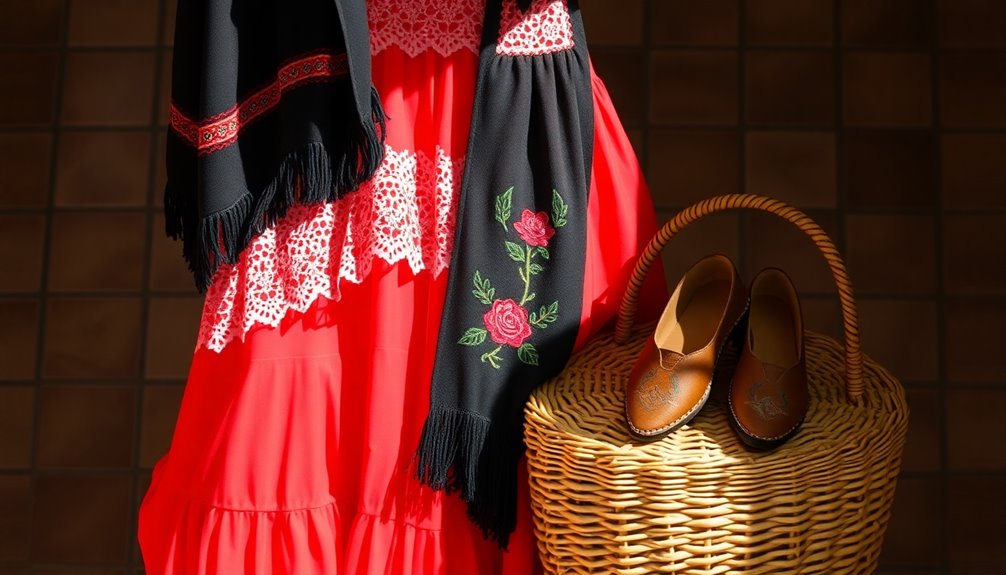
When it comes to Spanish style, your footwear choices can really elevate any outfit, so consider timeless options like espadrilles or flamenco shoes.
You can also play with flamenco-inspired layering techniques to add depth to your look while mixing vibrant textiles for a bold statement.
Timeless Spanish Footwear Options
Timeless footwear options from Spain offer a blend of style, comfort, and cultural heritage that can elevate any outfit. When you think of traditional Spanish footwear, espadrilles and alpargatas immediately come to mind. These versatile shoes, with their braided jute soles, provide a chic yet casual look perfect for summer outings.
Pair them with a flowing dress or tailored shorts for an effortless, stylish vibe.
If you're looking for something more elegant, consider bailarinas, or ballet flats. Often worn with flamenco dresses, these soft leather shoes add a touch of grace to your ensemble. They're practical for dancing yet stylish enough for everyday wear.
Don't overlook albarcas, the wooden-soled shoes from Asturias known for their comfort and durability. They work well in both rural and urban settings, making them a fantastic addition to your wardrobe.
Finally, incorporate a txapela, the traditional Basque beret, to complete your look. This accessory not only highlights regional craftsmanship but also adds a unique flair to any outfit.
Flamenco-Inspired Layering Techniques
To create a flamenco-inspired look, you'll want to embrace the art of layering with flair and intention. Start with a fitted bodice that hugs your figure, pairing it with a flowing skirt adorned with ruffles and playful polka dots. This combination reflects the traditional traje de flamenca style, capturing the essence of Andalusian culture.
Next, add a mantón de Manila shawl, featuring intricate embroidery. This versatile piece can be elegantly draped over your shoulders or tied at your waist, adding sophistication to your outfit. Opt for vibrant colors like red, black, or white to echo the passionate spirit of flamenco.
Mixing textures such as lace and silk enhances the rich visual appeal of your ensemble.
Don't forget to accessorize! A decorative peineta comb can secure your hair in a beautiful bun or updo, adding that traditional touch. For footwear, choose classic flamenco shoes with a sturdy heel. They'll not only elevate your look but also provide comfort and support for movement and dance, essential elements of flamenco culture.
With these layering techniques, you'll embody the captivating spirit of flamenco in no time!
Colorful Textile Combinations
Embracing colorful textile combinations can elevate your flamenco-inspired wardrobe beyond traditional layering techniques. To start, incorporate vibrant floral patterns typical of flamenco dresses. These lively designs not only enhance your outfit but also represent rich cultural heritage.
You can mix and match colorful textiles by pairing the intricate embroidery found in regional garments like the traje fallera with solid pieces. This creates a balanced yet striking look that stands out.
Don't forget about accessories! A mantón de Manila, with its intricate designs, adds layers of texture and color to simple outfits, infusing them with a traditional flair. Experiment with contrasting color combinations inspired by traditional Spanish attire; think bold pairings like red and black or playful bright polka dots.
Additionally, choose textiles that reflect regional influences. Heavier fabrics from Basque costumes lend a structured look, while the light, flowing materials of Andalusian garments bring elegance and movement to your ensemble.
Shopping Guide
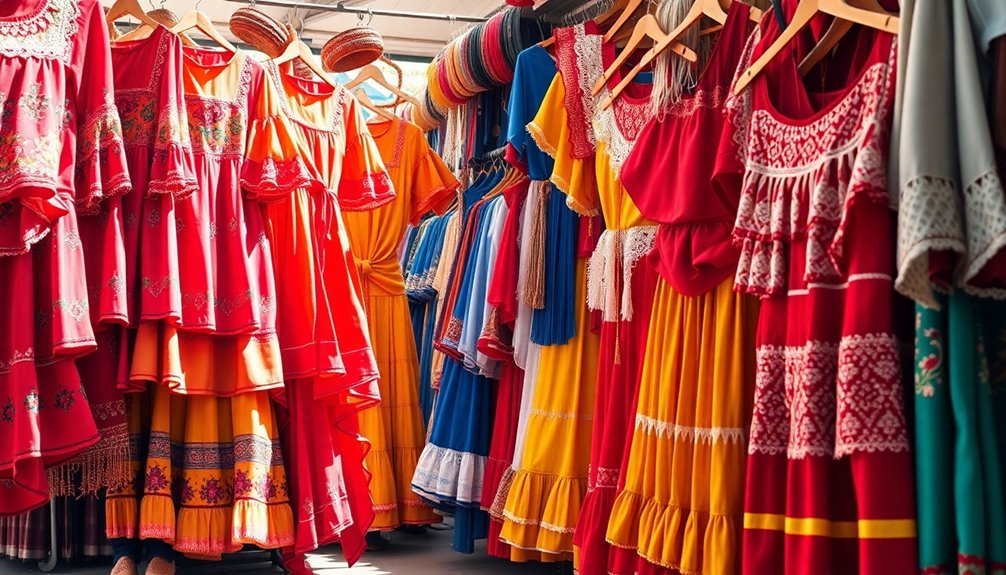
When you're on the hunt for traditional Spanish clothing, you'll want to seek out iconic pieces that reflect the rich cultural heritage of the regions.
Start with the flamenco dress, or traje de flamenca, known for its vibrant colors and ruffles. You can find these beautiful dresses in local boutiques and specialty stores throughout Andalusia.
If you're in Valencia, don't miss the traje fallera, characterized by its voluminous skirts and intricate lace. These garments are typically available in artisan shops, especially during the festive Las Fallas season.
For a taste of Madrid's culture, explore markets for chulapo and chulapa costumes, featuring fitted pants and polka dot skirts, ideal for celebrations like Fiesta de San Isidro.
In the Basque Country, check out regional craft fairs for traditional clothing like the baserritarra, which includes long skirts and unique accessories like the txapela hat.
Finally, enhance your outfits with accessories such as the mantilla and peineta, easily found in lace shops or cultural markets across Spain.
With these tips, you'll be well-equipped to build a wardrobe steeped in tradition.
Upcycling Traditional Fabrics
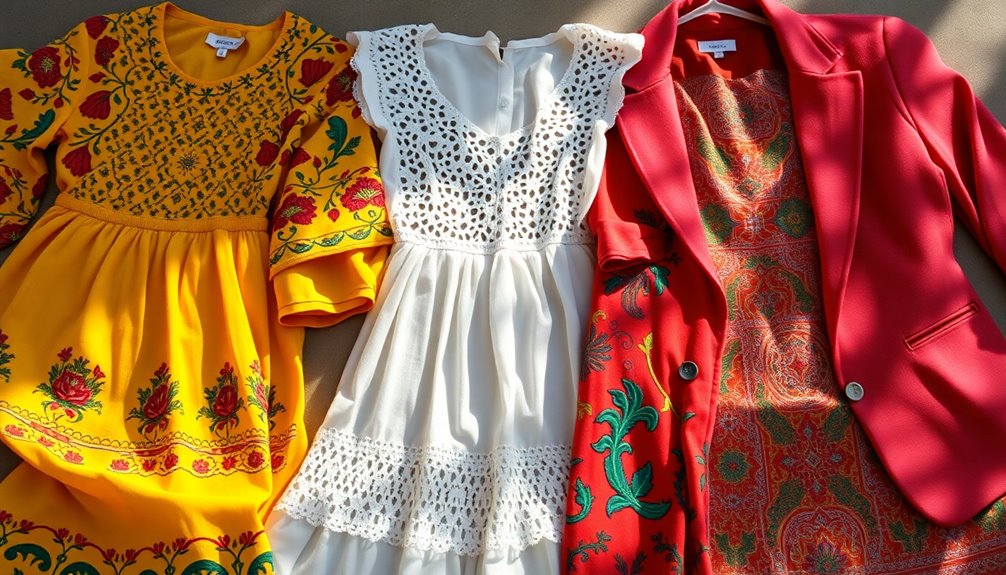
When you think about upcycling traditional fabrics, imagine repurposing vintage garments like flamenco dresses into fresh, stylish pieces.
You can even embroider your own personal motifs onto these fabrics, giving them a unique touch while honoring their heritage.
This process not only reduces waste but also celebrates the vibrant artistry of Spanish textiles.
Repurposing Vintage Fabrics
Repurposing vintage fabrics breathes new life into traditional textiles, transforming them into modern fashion statements while honoring their cultural roots. By embracing upcycling traditional fabrics, you can create unique pieces that reflect your personal style and celebrate Spain's rich heritage.
Imagine turning a vintage flamenco dress or a beautiful mantilla into a chic jacket or a trendy bag, all while preserving the intricate craftsmanship and vintage Spanish patterns woven into the fabric.
This sustainable practice not only minimizes textile waste but also revitalizes historical fabrics, allowing you to connect with the artistry of Spanish textile craftsmanship. Designers are increasingly blending historical aesthetics with contemporary silhouettes, giving you a chance to wear pieces that carry stories of the past.
As the popularity of upcycled fashion grows, it aligns perfectly with global trends toward sustainability. By choosing to incorporate repurposed traditional fabrics into your wardrobe, you're making a conscious choice that supports artisanal techniques and contributes to a more sustainable fashion industry. Furthermore, engaging in this practice promotes self-discipline and consistency, essential traits for personal growth that can be reflected in your wardrobe choices.
Embroider Personal Motifs
Incorporating personal motifs into your upcycled garments not only enhances their uniqueness but also allows you to weave your own story into the rich tapestry of Spanish tradition. By selecting vintage or traditional Spanish fabrics, you can create embroidered vests and other pieces that celebrate your cultural heritage while embracing sustainable fashion.
Utilizing Spanish embroidery techniques, like punto de cruz and bordado, you can embellish your garments with symbols that hold personal significance or reflect regional designs. This practice honors the artistry of historical garments and revives traditional craftsmanship, fostering a deeper connection to your roots.
Imagine stitching in motifs from Spanish folklore, adding layers of meaning to your clothing. Each stitch becomes a conversation starter, inviting others to appreciate your story and the cultural heritage behind your attire.
By upcycling traditional fabrics in this way, you not only create one-of-a-kind pieces but also promote a more sustainable approach to fashion. Ultimately, personalizing your garments enriches their narrative, allowing you to wear your identity proudly while honoring the timeless beauty of Spanish traditions.
Embrace this creative journey and make your wardrobe a true reflection of who you are.
Cultural Impact
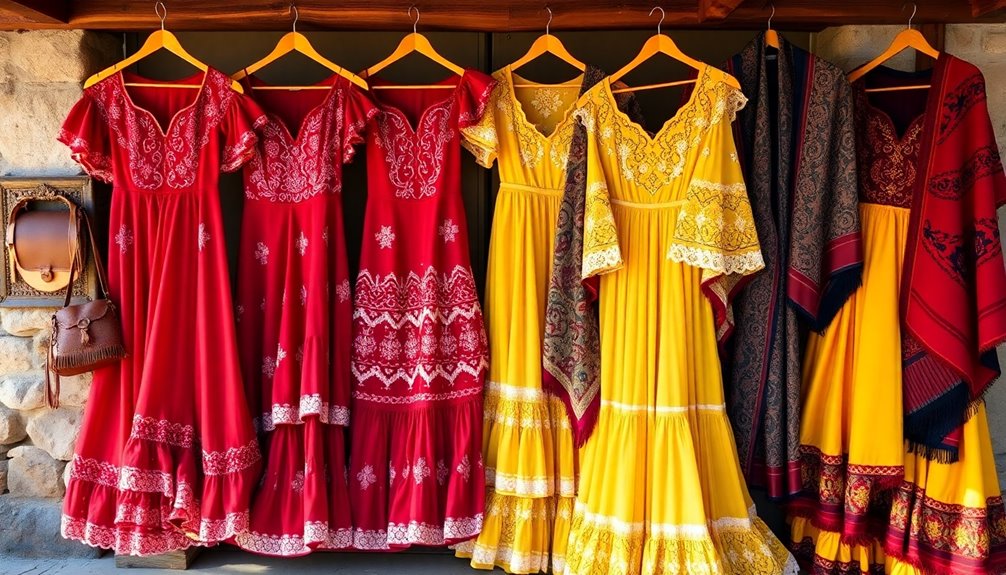
When you think about the cultural impact of Spanish style clothing, consider how flamenco influences modern music and fashion.
This vibrant dance not only showcases traditional attire but also sparks cultural activism, encouraging people to express their heritage.
Flamenco in Modern Music
Flamenco regularly finds its way into modern music, breathing new life into genres like pop and jazz. The passionate guitar rhythms and emotive singing that define flamenco music have deep roots in Romani, Moorish, and Andalusian cultures, creating a rich blend of influences. Artists like Rosalía showcase this fusion, blending traditional flamenco with contemporary sounds, which helps attract new audiences and keeps the genre fresh.
The visual aspect of flamenco dance, often performed in vibrant traditional costumes, adds another layer to its cultural impact. The expressive movements not only enhance the music but also reflect the emotional depth of the melodies.
Major flamenco festivals, such as the Bienal de Flamenco in Seville, celebrate both traditional and modern interpretations, demonstrating flamenco's adaptability and ongoing relevance in today's cultural landscape.
With its global popularity, flamenco has gained recognition from UNESCO as an Intangible Cultural Heritage of Humanity. This acknowledgment underscores its importance in preserving cultural identity and promoting cultural exchange.
Cultural Activism Through Fashion
Cultural activism through fashion fosters a deep connection to heritage and identity, especially in Spain. Traditional clothing plays a crucial role in preserving regional identities, often showcased during vibrant festivals and special events.
As you explore Spanish fashion, you'll notice how many designers weave traditional elements into contemporary collections, blending modern aesthetics with cultural significance. This approach not only enhances appreciation for local craftsmanship but also keeps the conversation around heritage alive.
Organizations dedicated to cultural preservation work tirelessly to promote traditional garment-making techniques, ensuring these skills are passed down through generations. Fashion shows increasingly highlight traditional attire, raising awareness of Spain's rich cultural heritage and encouraging public engagement.
What's fascinating is the revival of interest among younger generations, who are increasingly embracing cultural activism through fashion. They seek to connect with their roots and express their identities in today's globalized world.
Frequently Asked Questions
What Is Traditional Spanish Clothing Called?
Traditional Spanish clothing is often called by specific names that reflect regional styles. You might recognize terms like "traje de flamenca," "traje chulapo," or "traje de luces," each representing different cultural heritages.
Women often wear the "mantilla," a beautiful lace or silk veil, during special events.
In regions like the Basque Country, you'll find the "baserritarra," showcasing unique skirts and shirts that highlight local traditions and pride.
What Is the Clothing Style in Spain?
Spain's clothing style blends vibrant tradition with modern influences.
You'll see iconic pieces like flamenco dresses and tailored suits, each reflecting regional heritage. Women often wear outfits adorned with intricate embroidery and ruffles, while men sport stylish hats and sashes.
Accessories like lace veils and decorative combs elevate these looks. As you explore Spanish fashion, you'll find it continuously evolves, celebrating its rich culture while embracing contemporary trends.
What Do Men Traditionally Wear in Spain?
In Spain, men traditionally wear outfits that reflect their rich cultural heritage. You might see the traje de luces, a vibrant bullfighter's costume adorned with intricate embroidery.
In Andalusia, the traje corto combines fitted trousers and a short jacket, showcasing regional pride. Accessories like the sombrero cordobés and faja sashes complete the look.
Each region boasts unique styles, such as the Hereu suit in Cataluña or the Baseritarra attire in the Basque Country.
What Is the Name of Spanish Clothing?
When you explore traditional Spanish clothing, you'll encounter a variety of names that reflect the rich culture.
Key garments include the flamenco dress, known as traje de flamenca, and the traje de luces worn by bullfighters.
You might also hear about the mantilla, a lace veil, and regional attire like the Fallera dress from Valencia or Chulapo costumes from Madrid.
Each piece tells a story of Spain's diverse heritage and vibrant traditions.
